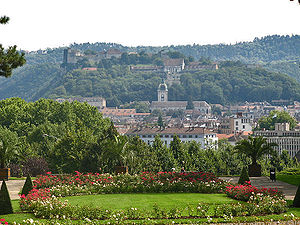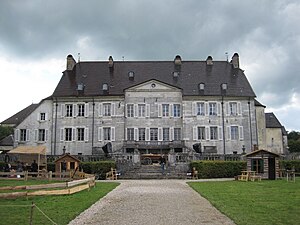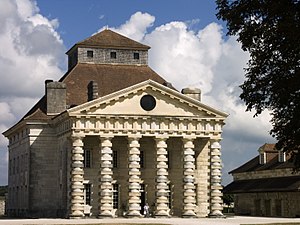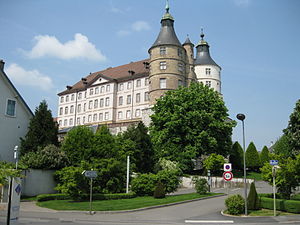 | |
 | |
| Doubs department | |
| Capital | Besançon |
|---|---|
| Residents | 541.454 (2018) |
| surface | 5,234 km² |
| no tourist info on Wikidata: | |
| location | |
 | |
The Doubs is a department in the French region Franche-Comté. It is named after the river of the same name in eastern France. The department borders in the north Haute-Saône, in the northeast to that Territoire de Belfort, in the east and south-east to the Switzerland (Cantons law, Neuchâtel and Vaud as well as in the west to the département law.
Regions

places
- 1 Besançon
 - is the prefecture (administrative seat) of the department. The Poudrey Gorge, the Dino Zoo, the grottes d'Osselle, Arc-et-Senans, Quingey
- is the prefecture (administrative seat) of the department. The Poudrey Gorge, the Dino Zoo, the grottes d'Osselle, Arc-et-Senans, Quingey - 2 Maîche
 - with St-Hippolyte, Vaufrey, Soulce-Cernay, Château de l'Hermitage, Les Breseux, Goumois, Charmauvillers, La Goule, Damprichard, Charquemont, les échelles de la mort.
- with St-Hippolyte, Vaufrey, Soulce-Cernay, Château de l'Hermitage, Les Breseux, Goumois, Charmauvillers, La Goule, Damprichard, Charquemont, les échelles de la mort. - 3 Montbeliard
 - with Sochaux, Mont-Bart, Mandeure, Pont-de-Roide, Montécheroux
- with Sochaux, Mont-Bart, Mandeure, Pont-de-Roide, Montécheroux

Besançon

Maîche
Montbeliard
- 4 Morteau
 - with Villers-le-Lac, Le saut du Doubs, the Cirque de Consolation.
- with Villers-le-Lac, Le saut du Doubs, the Cirque de Consolation. - 5 Ornans
 - with Cléron, Montgesoye, Vuillafans, Châteauvieux-les-Fossés, Mouthier-haute-Pierre and the upper Loue valley. Nans-sous-St.Anne with its Taillanderie, its castles, its via ferrata, its Grotten du Verneau and the springs (and gorges) of the Lison.
- with Cléron, Montgesoye, Vuillafans, Châteauvieux-les-Fossés, Mouthier-haute-Pierre and the upper Loue valley. Nans-sous-St.Anne with its Taillanderie, its castles, its via ferrata, its Grotten du Verneau and the springs (and gorges) of the Lison. - 6 Pontarlier
 - with Remonot, Montbenoit, La République du Saugeais, Ouhans, Source de la Loue, la Cluse-de-Mijoux, Château de Joux, Grand Taureau, Metabief, Le Mont d'Or, Lac Saint-Point, Malbuisson, La source Bleue , St.Point, Lac de Remoray, Mouthe, source du Doubs.
- with Remonot, Montbenoit, La République du Saugeais, Ouhans, Source de la Loue, la Cluse-de-Mijoux, Château de Joux, Grand Taureau, Metabief, Le Mont d'Or, Lac Saint-Point, Malbuisson, La source Bleue , St.Point, Lac de Remoray, Mouthe, source du Doubs.
Morteau
Ornans

Pontarlier
Other goals
- 1 Saline royale d'Arc-et-Senans - The salt works, founded in 1775, should become the nucleus of an ideal city. It was finally shut down in 1962. The buildings are well preserved and belong to the UNESCO world cultural heritage.
- 2 You sauté doubs - is a waterfall
- 7 Lods
 - is a village on the Doubs in Franche-Comté, classified as one of the most beautiful villages in France.
- is a village on the Doubs in Franche-Comté, classified as one of the most beautiful villages in France.

Administration building of the Arc-et-Senans saltworks

Le Saut du Doubs
Lods
background
The department is shaped by the river Doubs of the same name. It extends over an area of 5,260 km² with 35 cantons and 597 municipalities and consists of a department level in the north: Trouée de Belfort-Montbéliard, Doubs Valley towards Besançon, with an altitude between 240 and 600 meters. The south consists of plateaus (Haut-Doubs) with pastures and fir forests. All waterways form a network of 1,654 km in length. The Rhone-Rhine Canal was dug in 1783.
Metallurgy, automotive and accessories industries are represented in the north, watch, milk, paper and agricultural industries in the south.
language
getting there
mobility
Tourist Attractions
activities
kitchen
- Saucisse de Morteau, or Belle de Morteau, is a specialty from Morteau. It is a smoked pork sausage. Every year in August there is the sausage festival, Fete de la Saucisse, celebrated with a big procession.
- Liqueur de sapin is a light green liqueur made from pine buds or pine needles. With an alcohol content between 35% and 40%, the sugar content is more than 100 grams per liter, a very sweet affair. It was invented in 1902 by the absinthe distiller Armand Guy, from the Pierre Guy de Pontarlier distillery. At that time, the use of fir tree buds in medicine was common, and the idea of making a liqueur from them was new. The drink experienced a significant boom in the region after the authorities banned absinthe in 1915. It should preferably be drunk chilled and is recommended as an aperitif or at the end of a meal.

Saucisse de Morteau

Saucisse de Morteau with lentils
nightlife
security
climate
trips
literature
Web links
https://www.doubs.fr/ - Official website of the Doubs department














.jpg/350px-Le_saut_du_Doubs_(The_jump_of_the_Doubs).jpg)



.JPG/338px-0_Lods_-_Le_village_et_la_Loue_(2).JPG)


